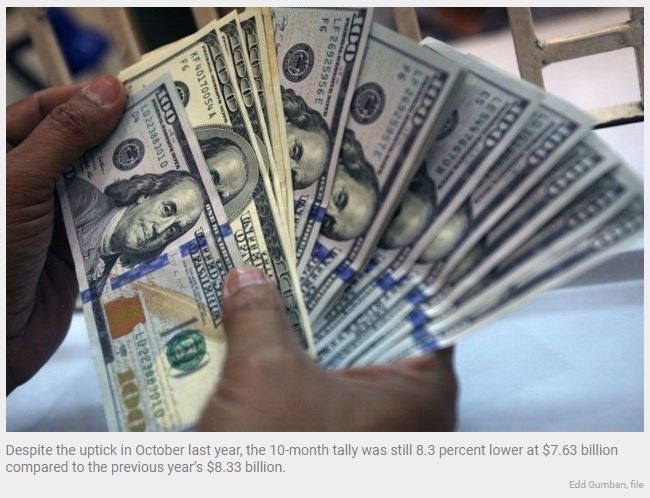Philippines: FDI inflow hits 6-month high in October
MANILA, Philippines — The net inflow of foreign direct investments (FDIs) climbed by 6.3 percent to hit a six-month high of $923 million in October last year from $868 million in the same month in 2021, according to the Bangko Sentral ng Pilipinas (BSP).
However, despite the uptick in October last year, the 10-month tally was still 8.3 percent lower at $7.63 billion compared to the previous year’s $8.33 billion.
The net FDI inflow in October last year was the highest since the $1.02 billion recorded in April, the BSP said.
Michael Ricafort, chief economist at Rizal Commercial Banking Corp., attributed the increase to the further reopening of the economy toward greater normalcy with no more COVID restrictions, helping boost sales, earnings and overall investment valuations.
He said the investment commitments obtained by the Marcos administration from state visits in recent months also boosted the net FDI inflow.
Investments in debt instruments, consisting mainly of intercompany borrowing between foreign direct investors and their subsidiaries or affiliates in the Philippines, increased by five percent to $667 million in October last year from $635 million in the same month in 2021.
“Despite the global economic headwinds, FDI net inflows rose on account of the increase in non-residents’ net investments in debt instruments and equity capital of their local affiliates,” the BSP said.
It said equity placements went up by 22 percent to $188 million in October last year from $154 million in October 2021. These funds, which came mainly from the US, Japan and Singapore, were channeled to financial and insurance, manufacturing as well as real estate sectors.
Likewise, withdrawals surged by 32.9 percent to $18 million in October last year from $13 million a year ago.
On the other hand, the BSP pointed out that reinvestment of earnings slipped by 6.8 percent to $85 million in October last year from $92 million in the same month in 2021.
From January to October last year, the net FDI inflow declined by 8.3 percent to $7.63 billion from $8.33 billion in the same period in 2021 as reinvestment of earnings went down by 7.6 percent to $1.01 billion from $1.09 billion, while investments in debt instruments slipped by 0.3 percent to $1.26 billion from $1.27 billion.
Capital inflows mainly from Japan, Singapore and the US decreased by 8.9 percent to $1.47 billion in the 10-month period from $1.62 billion a years ago, while withdrawals fell by 40.1 percent to $210 million from $351 million.
Ricafort said the elevated inflation, the weakening of the peso to an all-time low of 59 to $1, the sharp increase in key policy rates led by the US Federal Reserve to tame inflation, and the possible recession in the US dragged new FDIs, both globally and locally.
“The slower net FDIs recently in previous months may have to do with higher inflation and global interest rates that tend to weigh on FDIs,” Ricafort said.
According to Ricafort, the aggressive Fed rate hikes earlier in 2022 raise the risk of recession in the US. He said a recession in the world’s largest economy could slow down global trade, FDIs, remittances, employment and other economic activities worldwide.
Ricafort said FDIs remain one of the bright spots and one of the major pillars of the economic recovery program from the pandemic for the Philippine economy.
Furthermore, he said the approval of reform measures in recent months, especially the CREATE Law that reduces the corporate income tax by at least five percentage points (from 30 percent) retroactive July 2020 and provides greater certainty on investments would also continue to help attract more FDIs to be more decisive and locate in the Philippines.
Other reform measures to ease foreign ownership limits as already signed into law such as the amendments to the Public Services Act, Foreign Investments Act, Retail Trade Liberalization Act, among others would all further encourage and attract more FDIs into the country.
The BSP further lowered its net FDI inflow target to $8.5 billion from the original target of $10.5 billion for 2022 and to $11 billion instead of $12.5 billion for 2023.
Source: https://www.philstar.com/business/2023/01/12/2236927/fdi-inflow-hits-6-month-high-october


 English
English




